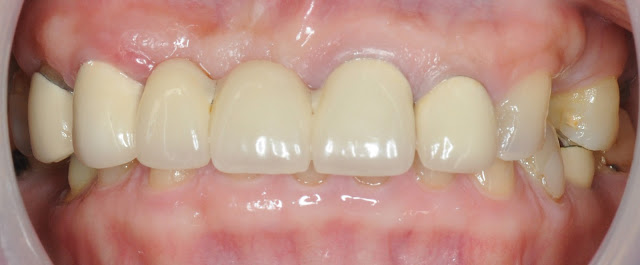病患: ‘ 医生,我牙齿很痛, 我要马上解决他, 把它拔掉吧,一劳永逸“
检查后。。。
医生:’ 拔掉?您确定吗? 其实我们还有方法帮您解决疼痛然后进行治疗就可以延长牙齿可使用的期限。。。。。。”
病患:’ 这么麻烦呀。。还要来几次,又只是延长期限罢了。。把它拔掉一了百了,不会再让我有什么困扰。。“
这种熟悉的情景时不时会在日常诊间重演。。
很多老年人认为:牙齿掉了就掉了,人都老了,就别折腾了。
提醒:这样不仅会让牙齿越掉越快,还容易引发龋齿、口臭、牙周病等口腔疾病。
是老了掉牙还是掉牙而变老呢?
当一颗牙齿拔了后, 并不是一劳永逸的。
如果缺牙没有替代, 除了美观问题还有一些后续持续性问题。
1) 临近牙齿会倾斜,间接造成食物残渣卡着,然后提高蛀牙的机率
2) 上牙会往下长,变长。 牙龈受伤, 或者照常咬和干扰,
间接造成假牙制 作困难度提高
3) 牙龈萎缩,骨头流失, 接着造成制作义齿复杂性和难度提高
4) 惯性一边咀嚼食物照成脸部肌肉不对称
没错,后牙拔除没有美观问题。
可是后牙是支撑我们的咬合高度和咀嚼食物, 如果缺失会影响消化功能也会影响脸型的美观之外。
门牙区域就会做代偿, 那么门牙会更快损坏或断裂,这些是一个恶性循环结果, 得不偿失。
#K 女士是我们的顾客,从家家第一年开业到现在断断续续都会来找我们帮他解决牙齿的问题。 这样子持续了三十年了。
……去年, 他因为门牙牙桥摇晃而在几年后出现在我们的诊间……
经过一连串的资料收集发现原来`她的牙桥有断裂的历史然后又把它接的更长了。
其实是她的后牙长期缺失没装义齿 而照成咬合高度改变, 然后前牙代偿的结果就是牙桥断裂了。 咬合高度改变也会影响肌肉强度。
咬合高度变短(后牙缺失), 让下脸部跟着变短。 比较秀气瓜子脸渐渐的变成四方脸。 外形改变了。
这不是几个月内发生的, 它是经过几年的变化才会发现的后果。 如果一开始就装上义齿, 那么问题不就会这么严重。
 |
| 治疗前~下排牙齿完全覆盖在上排牙齿后( 深咬) |
 |
| 治疗后~下排牙齿冒出来了(咬合高度zen |
| 下脸部较短-四方脸 |
| 咬合高度改变-下脸部比较不方 |
牙齿拔掉后, 可以考虑3种假牙方案代替会拔掉的牙齿。
1) 活动性假牙
2) 固定式牙桥
3) 人工植牙
1) 活动性假牙
- 活动假牙的费用是最低的。与假牙基托为化学性连接,多选用成品牙,也可特制.
- 因为咬合力差,咀嚼效率低,吃饭前需要将食物切成小块,或者吃软一些的食物。在吃年糕或口香糖等有粘性的食物时,会十分苦难。咀嚼的时候,牙床的黏膜部分有可能出现疼痛。
- 活动假牙戴在黏膜上,而黏膜又属于软组织,随着时间的推移黏膜会有变化,于是就需要经常调节假牙与黏膜面接触的一侧,用着非常不舒服的时候还需要重新制作。
2) 固定式牙桥
- 外观和不适感比较少,如果使用全瓷材料(不含金属)修复会更美观,但费用较高。
- 如果基牙没有问题,并得到良好的牙体预备(做固定假牙前将两侧牙磨小)、印模(咬牙印)、设计、制作,基本能达到与天然牙一样的效果。
- 初次制作的时候需要磨掉大部分的牙釉质,也就是人为磨掉了牙齿最坚硬的保护层,导致基牙比天然牙更容易得蛀牙。当任何一侧的基牙被蛀了,都需要重新制作修复体。
- 固定牙桥的费用一般根据材料而定,临床上用的有金属材料、金属烤塑、贵金属烤瓷、全瓷材料等。
3) 人工植牙
- 外观基本和自己的牙齿没有区别,近年全瓷材料的普及与发展,不仅在功能上,外观上也能自然再现牙齿的形态。
- 种植牙的价格根据品牌、生产国家的不同而有所区别,历史比较悠久的种植体比较保障。
- 一旦种植体与骨结合后,就可以获得非常稳定的状态,但患者需要定期检查、维护,注意牙周病的防治。
其实, 把疼痛的牙齿拔掉就是一劳永逸吗? 就没有后顾之忧了吗?
身为医生有责任让我们的病患知道因果和各个方案的优缺点。然后自己依照自己的条件和考量做决定。
毕竟没有东西是永久性的。。有什么是永久的吗?
牙齿和牙科治疗也不例外。每一天在使用的牙齿就如每一天在用的汽车这样, 需要定期保养和照顾, 才能延长它们的使用期限呀。





































